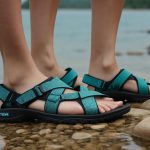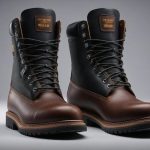Can you still maintain a normal daily routine while wearing a walking boot? Yes, you definitely can, with the right tips and adjustments. Adjusting to life in a walking boot isn’t always easy, but with some smart strategies, you can manage discomfort and keep moving forward effectively.
Understanding how to wear a walking boot correctly is key to healing and getting back on your feet faster. This introduction will guide you through essential tips to make your journey with a walking boot as smooth as possible.
Here are the key takeaways you’ll learn about:
- Choosing the Right Boot: Opt for a tall boot over shorter options to ensure adequate support.
- Balancing Act: Use a shoe leveling device on the non-affected foot to maintain balance and prevent further injury.
- Protection Measures: Use weather covers and protective bags to keep the boot dry and clean.
- Comfort Tips: Employ a sleeping pillow and take shorter steps to enhance comfort and reduce body strain.
- Healing Expectations: Set realistic healing timelines and consider necessary lifestyle adjustments during recovery.
- Proper Use and Care: Learn through video tutorials about using your walking boot, and consult with a podiatrist for personalized fit and advice.
This post will provide practical advice for navigating daily activities, ensuring you don’t just cope but thrive while wearing a walking boot.
Best Tips for Wearing a Walking Boot Video:
Contents
To maximize comfort and support while wearing a walking boot, it’s crucial to focus on proper fit, balance, and care. Here’s a straightforward guide:
Proper Sizing and Fit
Ensuring that your walking boot fits correctly is fundamental to avoid additional injuries and discomfort. Consult a podiatrist to get professionally fitted, and don’t hesitate to ask for a demonstration on how to properly wear the boot. Here’s a guide on fitting a walking boot.
Maintaining Balance
Use a walking boot leveler on your opposite foot to maintain balance and prevent strain on your back, hips, and knees. This adjustment helps to normalize your gait, reducing the risk of falls or further injury.
Protective Accessories
Employ accessories like weather covers to protect the boot from environmental elements and shower bags to keep it dry. Additionally, consider a comfortable sleeping pillow to rest the foot at night and reduce swelling.
Reasons to wear a walking boot?
Wearing a walking boot is essential for supporting and accelerating the recovery process following foot or ankle injuries or surgeries.
Stabilization and Protection
- The rigid structure of a walking boot encases the injured area, safeguarding it from external impacts and movements that could disrupt the healing process.
Weight Distribution
- A walking boot helps distribute body weight more evenly. This alleviates pressure on the injured foot or ankle, significantly easing pain and aiding in the healing of structures like bones and tendons.
Healing Enhancement
- By limiting unnecessary movement, a walking boot ensures the injured area remains aligned and stable, which is crucial for the natural healing process of bones and soft tissues.
Pain Management
- The support and immobilization provided by a walking boot can substantially reduce pain, making day-to-day activities more manageable for the wearer.
Mobility
- Despite the injury, a walking boot allows individuals to maintain a level of independence and mobility, which is vital for overall health and well-being during recovery.
Best Tips for Wearing a Walking Boot:
When sporting a walking boot for recovery, comfort, and proper healing are paramount. Below are streamlined tips to help you navigate this period effectively.
- Choose the Correct Boot Type: Opt for a tall boot as it provides enhanced support and stability, crucial for effective healing.
- Balanced Footwear: Utilize a walking boot level device on the non-affected foot to maintain balance and alleviate uneven pressure on your back and hips.
- Protection Against Elements: Shield your boot with weather covers or cast protective shower bags to keep it dry and clean, particularly during outdoor activities.
- Nighttime Comfort: Place a sleeping pillow under or around the boot while resting or sleeping to reduce discomfort and prevent nighttime movements that could disrupt healing.
- Activity Limitations: Minimize your walking duration. Extended use can impede healing and increase discomfort. Short, gentle walks are preferable.
- Proper Fitting and Usage: Watch tutorial videos for correct boot fitting and sizing to ensure it’s not too tight or loose, which can affect functionality and comfort.
- Consultation with Podiatrist: If you experience swelling or discomfort, consult a podiatrist to adjust the boot or explore additional supportive measures like compression wraps.
- Use Supportive Aids: Consider aids like walkers or knee scooters for mobility without exerting pressure on the injured foot, especially for indoor use.
Best Walking Boot Supplies:
The essential supplies for properly wearing a walking boot include items designed to maintain comfort and enhance the boot’s effectiveness. These supplies are crucial for individuals aiming to recover while staying active. Here’s a detailed look:
| Item | Description | Purpose |
| Boot-cut or Wide-leg Pants | Pants with a relaxed fit through the leg | Facilitates easy wearing of the boot without constricting movement or causing discomfort |
| Cushioned Socks | Thick, soft fabrics like bamboo or merino wool | Provides padding, absorbs moisture, and reduces friction between the boot and skin |
| Compression Wraps | Elastic bandages or specially designed compression garments | Helps reduce swelling and stabilizes the foot within the boot |
| Supportive Aids | Crutches, canes, or walkers | Assists in movement, ensuring no undue pressure is put on the injured foot |
| Lightweight Jackets or Sweaters | Easy to put on and remove; made from materials like cotton or fleece | Keeps the body warm and comfortable without interfering with the boot |
Selecting the right clothing and accessories, such as boot-cut pants and cushioned socks, is key to minimizing discomfort.

Best Scooter Supplies:
When maintaining and using a scooter, selecting the right supplies can significantly enhance both safety and enjoyment. The key supplies, based on comprehensive maintenance needs and regular user experiences, include:
- Helmet: Essential for head protection in the event of a fall or collision.
- Gloves: To improve grip and protect hands during rides.
- Maintenance Toolkit: A set that includes tools specifically designed for adjusting screws, bolts, and cables which are crucial for regular upkeep.
- Tire Pump and Pressure Gauge: Vital for ensuring tires are at the optimal pressure, boosting performance and safety.
- Chain Lubricant and Cleaner: Necessary for smooth operation and to extend the life of the chain and sprockets.
- Battery Charger (for electric scooters): Ensures your scooter is always ready to ride, with a focus on prolonging battery life.
- Protective Covers: Useful for protecting the scooter from elements like rain and sun when parked outdoors.
Other Tips:
To optimise comfort and aid healing while wearing a walking boot, here are some nuanced, practical tips to consider:
Correct Placement and Adjustment:
- Always ensure the boot sits snugly around your foot and ankle without causing undue pressure. Adjust the straps at different times of the day as swelling increases or decreases.
Sole Support Adjustments:
- Insert additional cushioning insoles if the boot’s base feels too hard. These can alleviate pressure points and enhance comfort during extended wear.
Footwear on the Opposite Foot:
- To maintain an even gait and reduce stress on your hips and back, wear a shoe of similar height on the non-injured foot. A shoe leveler can be helpful here.
Movement and Exercise:
- Lightly exercise your foot and ankle within the boot as advised by a healthcare professional. This can help maintain circulation and muscle tone.
Skin Care:
- Check your skin daily for any signs of irritation or breakdown. If the boot rubs, consider padding the affected area or adjusting the boot’s fit.
Hygiene and Maintenance:
- Keep the boot and your foot clean to avoid any infections. If the boot is not meant to be worn during showers, use a protective cover.
Usage Guidelines:
- Follow your healthcare provider’s guidelines on when to wear the boot and when it can be safely removed, such as during rest or sleep.
What if I have walking boot discomfort or pain?
To alleviate discomfort or pain while wearing a walking boot, employing a combination of practical adjustments and foot care strategies is key. Here are direct and effective tips:
- Choose Thick, Moisture-Wicking Socks: These socks keep your foot dry and prevent rubbing, a common source of discomfort in a walking boot.
- Insert Cushioned Insoles: Adding insoles provides necessary support, enhancing comfort while walking. These can be crucial for long periods spent in the boot.
- Soften the Blow: Ensure your walking boot has a softer inner lining to cushion your leg, ankle, and foot more effectively. This can dramatically reduce pain and irritation.
- Adjust the Fit: Utilize the boot’s fasteners to adjust the fit, particularly important to accommodate any swelling throughout the day or to conform to different foot shapes.
- Rest and Elevate: Whenever possible, rest and elevate your foot. This helps in reducing fatigue and swelling, promoting a quicker adjustment to the walking boot.
Conclusion
Navigating daily life while wearing a walking boot may seem like a steep challenge, but with well-considered strategies, it can be a bridge to better mobility and quicker recovery. The key is to don the boot with precision, ensuring it is properly fitted to prevent additional discomfort or injury. Balancing your stride with a shoe leveler on the non-affected foot can help maintain your natural gait, warding off potential strain on other parts of your body.
Furthermore, employing protective accessories keeps the boot in prime condition, shielding it from moisture and dirt, which is vital during outdoor activities or inclement weather. For nighttime relief, a strategically placed pillow can alleviate pressure and promote healing rest. By setting realistic expectations and making slight modifications to your routine, you can continue to engage in your day-to-day activities with minimal disruptions.
Finally, ongoing consultation with a podiatrist will fine-tune the fit and function of your boot, tailoring it to your specific needs.






